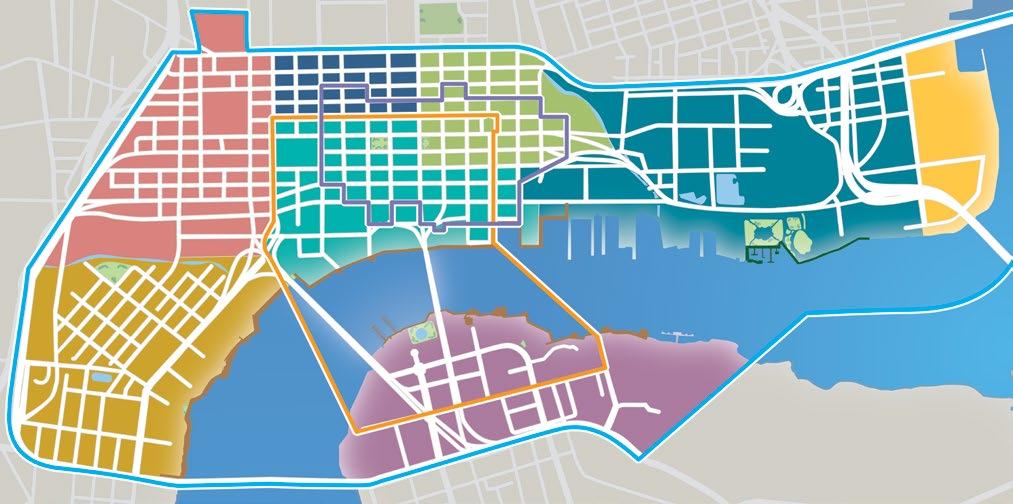
4 minute read
Downtown Diversity
As the heart of the arts, history, business, innovation, and civic engagement in Northeast Florida, Downtown Jacksonville is in the middle of it all. Office and residential towers flank nearly six miles of beautiful waterfront along the St. Johns River. With a daytime population of 67,000 and more than 6,100 calling Downtown home, employees and residents cite walkability, culture, entertainment, and the city atmosphere as the best things about the Downtown experience.
Getting to and from Downtown is easy with direct access via Interstates 10 and 95, and 40% of Downtwn’s employees enjoy commute times of 20 minutes or less. For travelers, Downtown is a quick 15-mile drive to the Jacksonville International Airport.
Downtown falls under a singular Commercial Central Business District (CCBD) zone to allow for a dense mixture of uses. The City of Jacksonville’s Downtown Investment Authority (DIA) guides and incentivizes investment, job creation, and residential density throughout Downtown, while the Business Improvement District (BID) provides Downtown with clean and safe services and stakeholder support in the 90-block central business district.
LAVILLA CHURCH CATHEDRAL
CENTRAL CORE
SPORTS & ENTERTAINMENT
WORKING WATERFRONT
BROOKLYN
SOUTHBANK

DOWNTOWN BOUNDARY (CRA) BID BOUNDARY HISTORIC DISTRICT
Downtown received a Historic District designation through the National Park Service's National Register of Historic Places in 2016. The district encompasses 64 blocks in the Central Core, Cathedral and Church District. According to the designation:
This particular area contains a contiguous group of resources that relate to the development of Downtown Jacksonville as a commercial, institutional, and residential hub for the city following the Great Fire of May 3, 1901. The contributing resources host a number of uses such as single family and multi-family dwellings, commercial business, financial institutions, social and religious activities and government operations. The architectural styles include Frame and Masonry Vernacular, Prairie and Chicago School, Colonial Revival, Mediterranean Revival, Neoclassical Revival, Beaux Arts, Renaissance Revival, Gothic Revival, Romanesque Revival, Modernist, and others.
EIGHT DOWNTOWN DISTRICTS
BROOKLYN. Modern and colorful, Brooklyn connects the Central Core to the historic Riverside neighborhood and Five Points shopping and dining district. Home to major headquarters, such as Black Knight Financial, FIS, Florida Blue, Haskell and TIAA Bank, Brooklyn offers an ideal location for businesses and residents alike. The district has a mix of uses, including riverfront office, multi-family housing, restaurants, retail and light industrial. The community enjoys plentiful river access, and with various major projects under way, Brooklyn is well positioned for continued growth and success.
LAVILLA. As Jacksonville’s oldest suburb, LaVilla was known as the Harlem of the South and the epicenter of black culture and commerce in Northeast Florida, as well as Jacksonville’s railroad hub. Following a decline in population and quality of life in the 20th Century, the The River City Renaissance (RCR) Plan aimed to revitalize the area in the 1990s, making room for future development through the acquisition and clearing of many acres. Development stalled for nearly thirty years, but recently, redevelopment has returned in the form of new workforce housing and transportation projects. The 2019 LaVilla Neighborhood Development Strategy calls for a LaVilla Heritage Trail for pedestrians and bicycles and a Water Street road diet to connect the historic district to the riverfront.
CENTRAL CORE. Jacksonville was founded on the riverbank of the Central Core and its small walkable blocks are filled with historic architecture, cultural amenities and public art. The district encompasses much of Downtown’s office towers, government services, regional non-profits, and various art and cultural centers. Today, work continues on key riverfront properties to enhance Jacksonville’s iconic skyline. The availability of several unique and historic properties provide significant opportunities for adaptive reuse.
CHURCH. Situated along the northern boundary of Downtown between the Central Core and the historic Springfield neighborhood, the district is at the onset of a major transition. Drawing its name from the multi-block First Baptist Church of Jacksonville campus, the area is ripe for redevelopment, with eight contiguous blocks currently for

sale and multiple adaptive reuse projects underway to bring residential, retail and a hotel to the district.
CATHEDRAL. Anchored by five historic churches, the Cathedral District connects the Central Core to the Sports & Entertainment District and is home to Billy Goat Hill, the highest point in Jacksonville. Beginning in 2016, the area has been championed by Cathedral District Jax-Inc. (CD-J), a nonprofit organized to foster growth as Jacksonville's Downtown neighborhood by supporting development and revitalization efforts.
SPORTS & ENTERTAINMENT. The biggest concentration of entertainment venues in Northeast Florida, the Sports & Entertainment District is home to five sports teams, major concerts, the annual Jacksonville Fair and much more. The district was once home to a thriving maritime industry, its riverfront lined with shipyards. Today, major mixed-use developments are planned to bring residents, employees, and visitors to the area.
WORKING WATERFRONT. The Working Waterfront sits on the eastern edge of Downtown. Home to the North Florida Shipyards, the district primarily supports industrial waterfront uses with a special district zoning overlay to accommodate the needs of shipping, lumber, concrete, oil and similar businesses operating there.
SOUTHBANK. Home to tall riverfront office and residential towers, the Southbank sits between the St. Johns River and the San Marco neighborhood to the south. It features a wealth of hotels and premier medical campuses including Baptist Medical Center, Wolfson Children’s Hospital, MD Anderson Cancer Center and Nemours Specialty Care center. The community enjoys plentiful riverfront access via the Southbank riverwalk, a boat ramp, kayak launch, and River Taxi stops.
The Cathedral District and the Sports & Entertainment District were designated as “Opportunity Zones” that offer investors tax breaks designed to encourage economic development in economically distressed areas created as part of the federal Tax Cuts and Jobs Act of 2017.








